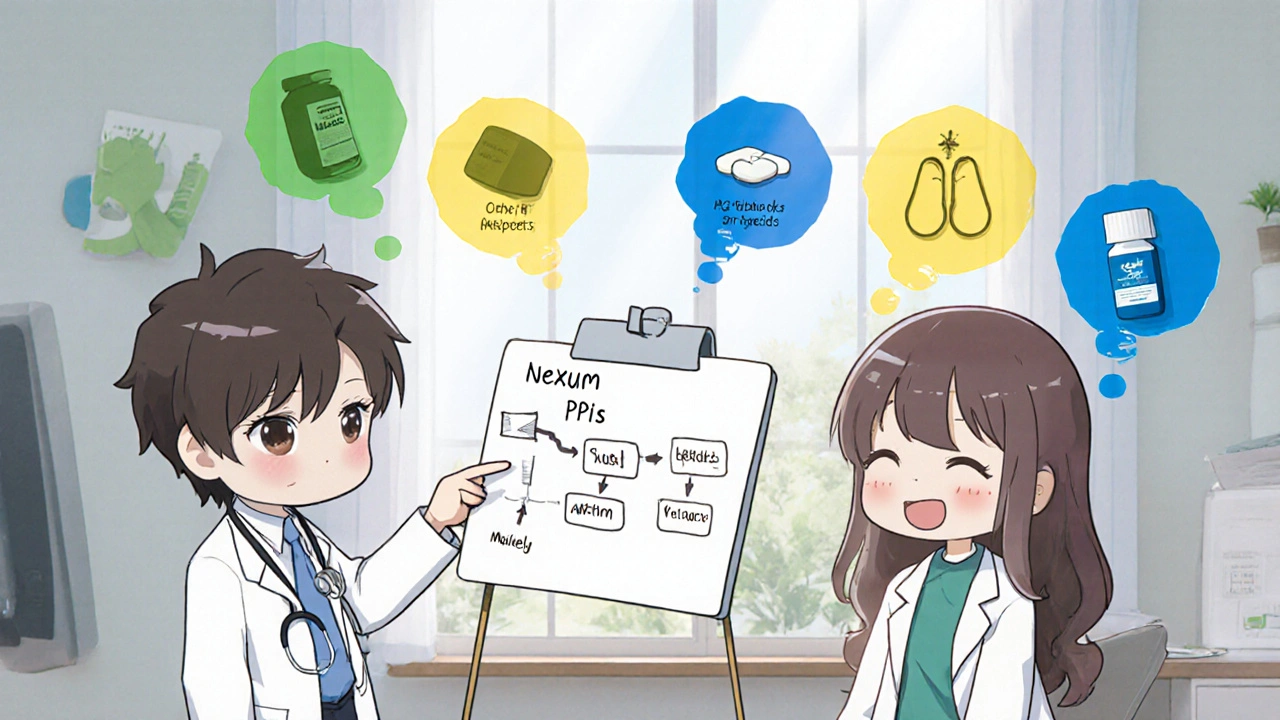Acid Reflux Treatment Advisor
Which Treatment Is Right for You?
This tool helps you compare treatment options based on your symptoms, budget, and medical needs. Answer a few questions to get personalized recommendations from the 2025 comparison guide.
Your Personalized Recommendation
Answer the questions above to see your personalized recommendation.
When your stomach starts acting up, the first thing you want is relief that actually works. Nexium has become a household name for that purpose, but is it the only game in town? This guide breaks down how Nexium stacks up against other prescription and over‑the‑counter options, so you can decide which acid‑reduction strategy fits your lifestyle and budget.
What is Nexium (Esomeprazole)?
Nexium is the brand name for esomeprazole, a proton pump inhibitor (PPI) that blocks the final step of acid production in the stomach. Approved in the UK in 2002, it’s prescribed for gastro‑oesophageal reflux disease (GERD), ulcers, and Zollinger‑Ellison syndrome. Typical adult dosing is 20‑40 mg once daily, taken before breakfast.
How Proton Pump Inhibitors Work
PPIs like Nexium target the H⁺/K⁺‑ATPase enzyme-the so‑called “proton pump”-in the parietal cells lining the stomach. By binding irreversibly, they shut down acid secretion for up to 24 hours. This prolonged suppression offers better symptom control compared with older classes such as H₂‑blockers, which only reduce the number of active pumps.
Direct Prescription Alternatives: Other PPIs
All PPIs share the same mechanism, but their chemical structures and pharmacokinetics differ slightly, which can affect cost, drug‑interaction profile, and how quickly they work.
- Omeprazole - the first PPI on the market; often the cheapest generic option.
- Pantoprazole - known for a lower interaction risk with clopidogrel.
- Lansoprazole - may have a faster onset for ulcer healing.
- Rabeprazole - highest bioavailability; useful for patients with rapid metabolism of other PPIs.
Choosing among them often comes down to price, insurance coverage, and personal tolerability.

Non‑Prescription Options: H₂‑Blockers
If you need occasional relief or want to avoid long‑term PPI use, H₂‑blockers are a solid fallback.
- Ranitidine - withdrawn in 2024 in the UK due to NDMA contamination concerns; replaced by famotidine‑based products.
- Famotidine - remains widely available OTC; takes effect within 30‑60 minutes and lasts ~12 hours.
These drugs reduce acid output by blocking histamine‑2 receptors on parietal cells, offering a shorter‑acting but safer profile for most people.
Over‑the‑Counter Antacids
For rapid, on‑the‑spot heartburn relief, antacids are the go‑to. They neutralise existing acid rather than preventing new production.
- Calcium carbonate (e.g., Tums) - provides quick relief but can cause constipation.
- Magnesium hydroxide (e.g., Milk of Magnesia) - effective but may lead to diarrhea.
- Combination formulations - balance calcium and magnesium to minimise side‑effects.
Antacids are best for occasional flare‑ups; they don’t address chronic GERD.
Side‑Effect Profile Comparison
| Drug | Class | Typical Dose | Onset (hrs) | Duration (hrs) | Average NHS Cost per 30‑day supply | Common Side‑Effects |
|---|---|---|---|---|---|---|
| Nexium | PPI | 20‑40 mg daily | 1‑2 | 24 | £12‑£18 (generic esomeprazole) | Headache, diarrhoea, low magnesium |
| Omeprazole | PPI | 20‑40 mg daily | 1‑2 | 24 | £5‑£9 (generic) | Nausea, abdominal pain |
| Pantoprazole | PPI | 20‑40 mg daily | 1‑2 | 24 | £7‑£11 | Flatulence, dizziness |
| Lansoprazole | PPI | 15‑30 mg daily | 0.5‑1 | 24 | £6‑£10 | Dry mouth, rash |
| Rabeprazole | PPI | 20 mg daily | 0.5‑1 | 24 | £9‑£13 | Headache, constipation |
| Famotidine | H₂‑Blocker | 20‑40 mg daily | 0.5‑1 | 12 | £2‑£4 (OTC) | Headache, fatigue |
| Calcium carbonate | Antacid | 500‑1000 mg as needed | 0.1 | 2‑4 | £1‑£2 (OTC) | Constipation, hypercalcaemia (rare) |

Pros and Cons: When to Choose Nexium vs Alternatives
When Nexium shines
- You need the strongest, longest‑lasting acid suppression (e.g., severe erosive esophagitis).
- You have tried cheaper PPIs and still experience breakthrough symptoms.
- Cost isn’t the primary barrier - NHS often covers generic esomeprazole.
When a cheaper PPI may be better
- You have a stable, mild‑to‑moderate GERD that responds to lower‑dose therapy.
- You’re on medications that interact with CYP2C19 (esomeprazole is a strong inhibitor).
- Budget constraints - generic omeprazole or pantoprazole can be 50‑70 % cheaper.
When to consider H₂‑blockers
- You only need occasional heartburn relief and want to avoid long‑term PPI risks (e.g., bone density concerns).
- You’re pregnant; many clinicians favour famotidine as the safest acid reducer.
When antacids are enough
- Symptoms are sporadic and triggered by meals or alcohol.
- You dislike taking a daily tablet and prefer chewable tablets or liquids.
Practical Tips for Switching or Starting Therapy
- Consult your GP or gastroenterologist before changing any prescription.
- Ask about a step‑down plan: start with a PPI, then move to an H₂‑blocker if symptoms improve.
- Check NHS formularies for the cheapest generic option that matches your clinical needs.
- Monitor for side‑effects: write down any new headaches, joint pains, or changes in bowel habits.
- Never combine PPIs with antacids without a doctor’s approval - the pH shift can affect drug absorption.
FAQs - Quick Answers
Is Nexium stronger than other PPIs?
Esomeprazole is the S‑enantiomer of omeprazole, which gives it slightly higher bioavailability. In practice, the difference is modest; most patients feel similar relief with generic omeprazole at the same dose.
Can I take Nexium with ibuprofen?
Yes, but PPIs are often prescribed specifically to protect the stomach when you need NSAIDs. If you’re on a low‑dose ibuprofen, a generic PPI usually suffices.
How long is it safe to stay on Nexium?
Guidelines suggest limiting continuous PPI use to 8‑12 weeks unless a specialist approves longer therapy. Long‑term use has been linked to low magnesium, B12 deficiency, and a slight increase in fracture risk.
Is famotidine safer for pregnant women?
Current UK obstetric guidelines list famotidine as Category B - meaning no proven risk in animal studies and limited human data, making it a preferred H₂‑blocker during pregnancy.
Do antacids interfere with other medicines?
Because antacids raise stomach pH, they can reduce absorption of drugs that need an acidic environment (e.g., ketoconazole, iron supplements). Take antacids at least two hours apart from such medications.

10 Comments
Kyle Garrity
I've been in the same boat trying to decide if Nexium is worth the extra cost. It does give a solid 24‑hour acid suppression, which can be a lifesaver for severe GERD. At the same time, many people find generic omeprazole just as effective for mild to moderate symptoms. If you're on a tight budget, checking the NHS formulary for the cheapest generic could save you a few pounds each month. Keep a symptom diary for a couple of weeks; it helps you see whether the stronger PPI actually makes a difference. And don't forget to discuss any long‑term plans with your GP – they can guide you on step‑down strategies.
brandon lee
Nexium works but it’s pricey.
Joshua Pisueña
Hey you can kickstart your gut health by trying a generic PPI first like omeprazole it’s cheap and often just as good give it a solid week see how you feel if the heartburn still bites you can then step up to Nexium for that extra punch remember consistent timing before breakfast makes the biggest impact.
Ralph Barcelos de Azevedo
It is disconcerting how often physicians default to brand‑name PPIs without first exhausting cheaper generics. While Nexium certainly has its place, the ethical imperative to consider cost‑effectiveness for patients cannot be ignored. Overprescription not only burdens the healthcare system but may expose individuals to unnecessary long‑term risks such as hypomagnesemia. A judicious trial of omeprazole or pantoprazole, with close monitoring, aligns better with the principle of “do no harm” both medically and financially.
Peter Rupar
Listen up the pharma machine is pushing Nexium like it’s the only goddamn cure cuz they love the profits and you’re just a stupid consumer buying into the hype! The price tag alone is a joke when a generic omeprazole can do the same job for a fraction of the cost. Stop being a pawn in their game and demand cheaper options before you end up bankrupt.
Nikita Shue
Alright folks, if you’re only getting occasional heartburn, ditch the daily pill and grab some famotidine OTC – it kicks in fast and won’t lock you into a long‑term PPI habit. For those with nasty night‑time reflux, a short trial of Nexium can give you relief, but set a calendar reminder to reassess after eight weeks. Staying proactive saves you from unnecessary medication creep.
Heather McCormick
Oh brilliant, the UK NHS decided to keep charging £12‑£18 for a generic version of esomeprazole while the rest of Europe gets it for pennies. Clearly the British government cares more about preserving their budget than actually helping patients. Guess we’ll just keep swallowing overpriced pills and hope the system magically fixes the problem.
Eddie Mark
Picture this: you’re battling a volcanic eruption of acid in your chest, and there’s Nexium, the heroic knight in shining armor, slashing the flames with a 24‑hour sword. Yet, lurking in the shadows are the humble antacids, the sneaky side‑kicks that neutralize the fire in seconds. Both have their stage, but the drama unfolds differently depending on whether you want a blockbuster or a quick cameo.
Danica Cyto
One might wonder why the pharmaceutical giants tout Nexium as the ultimate solution while subtly burying cheaper alternatives beneath layers of regulatory red tape. Could it be that the real agenda is to keep us dependent on constantly renewing prescriptions, ensuring a steady stream of revenue? It’s a question worth pondering as we navigate the maze of modern medicine.
Raja M
When we look at acid‑reduction therapy, it mirrors the balance we seek in life – a harmony between powerful intervention and gentle maintenance. A PPI like Nexium offers a strong, steady hand, but sometimes the softer touch of an H₂‑blocker or antacid aligns better with our body's natural rhythms. Listening to those subtle cues can guide us toward the most fitting choice.